I’ve been waiting to talk to you about Oath for a long time. Ever since demoing it at PAX Unplugged nearly two years ago, I’ve been obsessed with following this game. There have been several major changes to the design since then, but they’ve all been in favor of streamlining the game, doing that thing Cole Wehrle does, boiling down a game until all that remains is its sweet rock candy core. This game is polished to a mirror finish, sanded down on every single rough edge. To say it delivers on its promise is an understatement. But what exactly is Oath, what does it promise, and why am I making such a big deal out of it compared to any other game? Fair questions.
As with Root and Pax Pamir, other Wehrle designs, Oath follows something of a trend. This game, despite its adorable artwork (once again nailed by the fantastic Kyle Ferrin) and colorful look, has an in-your-face nature that’s definitely not for everyone (ok Pax Pamir admittedly isn’t “cute” in its look but the in-your-face part stands). I feel pretty comfortable saying that right out of the gate here. However, if it is for you, it does what it does in such masterful ways that you’ll likely find this game a must-buy. Is it for you? We’ve got some things to discuss, so let’s dive right in.
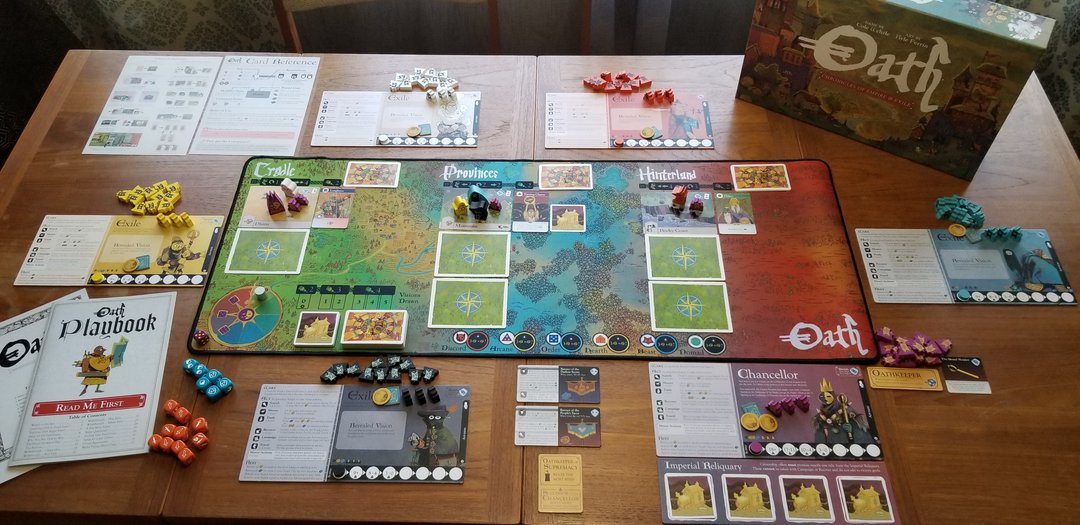
This game is remarkably respectful of table space. The thinner, longer playmat leaves space for the player boards, even on smaller tables like mine!
The Prologue
A new Chancellor has come to power. In a land where many disparate factions vied for power, one rises above all others. As two of his rivals plot against him, exchanging court agents to strike without fear of his defenses in the Cradle lands, a secret deal for power is made. The Chancellor invites his greatest enemy into citizenship, removing the one great threat to his power from the battlefield. Quelling the slight unrest it causes in his court, he now sits as ruler over these lands. No others can oppose his military might.
While the game design itself has iterated in the roughly 2 years since my preview from PAX, the core of Oath remains unchanged. If you’re just hearing about this game now, it goes something like this: players shift their forces, as well as a personal player pawn, around an ever-changing map of the land, vying for power as they go. Each game informs the next with a rotating pool of cards and a modular “map” that shifts with each victory. One of four oaths, the victory condition, is also swapped into each game, changing the tone of the conflict. Sometimes you’re playing for territory while others you’re playing for control of an objective that may change hands frequently. Subsequently, one game might then take the form of feuding warlords, while another takes shape as intrigue across the court, while yet another tells the tale of rebels trying to reunite a shattered kingdom, with each game building on the last. This is not, however, a legacy game. You won’t be asked to tear up any components or permanently alter the game board; in fact, you can reset the game to out-of-the-box at any time if you desire. Oath allows friends to drop in and out or adjust the player count in between games. It’s much more friendly in getting people to the table in that regard.
It’s also really mean! This game is as in-your-face as you want it to be (and often will be). A well-timed knife in the back is just as valid, and often more effective, a means of grasping a victory as it is to raise an invincible army to march across the land. I’ve already mentioned some of Cole’s other designs, Root and the second edition of Pax Pamir, and let me tell you this game can be no less political or confrontational in the struggles it presents. The difference here is that because the games are linked together in a changing world, backstabs don’t necessarily end friendships the way they do in other board games. The remnants of your once great force can get their chance for revenge, if that’s what your heart desires, in the next encounter. We’ll talk more about this in a bit but sufficed to say while betrayal for the win may be efficient in the short term, thinking about your long-term reputation is a consideration with its own ups and downs.
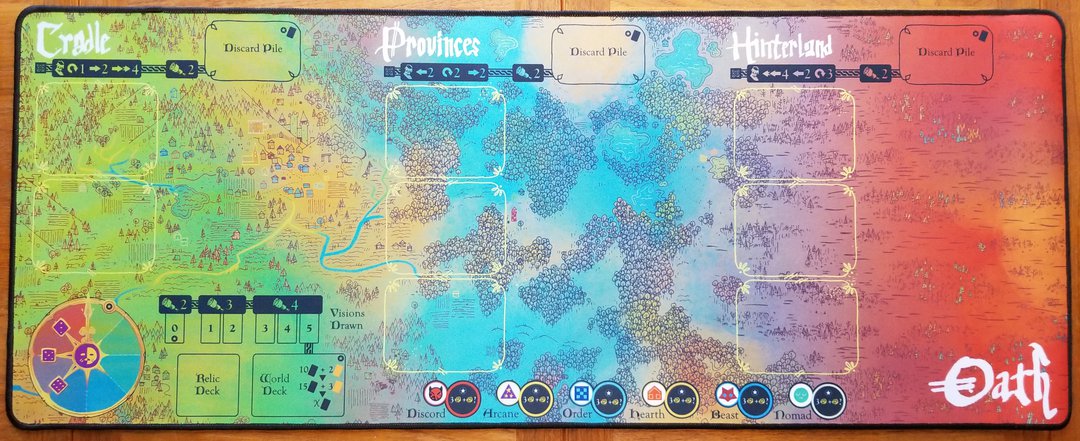
Speaking of that board, yes it's a playmat. This is the standard board for all retail copies of Oath! It fits inside the box nicely as well.
A Game Of Stories
Before the next era devolves once again into conflict, the Chancellor has his vassals swear an Oath of Devotion. And so, the next conflict is set in motion, a war not just of armies but of secrets. A slowly maddening ruler locks himself away in his throne room, paranoid of conspiracies and spies. He allows not a single advisor to join his court; advisors could one day betray him. Alone he claws at his remaining power as ever growing wars on his borders weaken him. Then, in his greatest hour of need, his citizen ally does the unthinkable. He quits the field, leaving the Chancellor’s armies to crumble against superior force. His once ally accepts ruin as the old empire crumbles, but their inaction ensures a new day dawns. A new ruler emerges from the ashes, waving the banner of the people, leading them through a Vision of Sanctuary. The reign of the despot is over and a new, peaceful era begins.
Oath is, at its heart, a sandbox of power and politics. It gives you all the tools to explore a land of ever-changing relationships. While the goal of each game is to fulfill the oath condition and secure victory, how you go about that is completely up to you. In fact, whether you even care about the crown is up to you! While I won’t give a full rundown of how the rules work (that would take way too long and you can find a copy of them on Leder Games’s resource page), if you are so inclined to simply push the boundaries of this game and do silly things just to see how the story unfolds, or what those rules permit, you are more than welcome to. In fact, sometimes it feels like the game encourages you to do just that, test its limits! This review is going to discuss more of the feel of what it's like to play Oath and a little bit of what makes it unique. Just to share some of the things I’ve seen in my own games, we’ve experienced: a player taking to the mountainous Hinterlands, passively settling hard to reach locations in an attempt to steal a win peacefully; a player intentionally trying to kingmake others into victory for two games only to be crowned chancellor himself; a player using no advisor cards, even though they add private powers to a tableau, out of pure fear of the Conspiracy card (requires advisors in your court who can “spy” on you); a “Robin Hood” player stealing the royal scepter from the Chancellor and using it to declare himself a legal, loyal citizen, usurping the throne and the game.
This game tells stories, as you’d hope of a title that purports to span epic ages of conflict and power. However, it does this in a truly marvelous way. There is no book with text to read at intervals. There is no flavor text on the cards themselves. It is by power of the game’s clean mechanics and artwork, how they perfectly mesh with theme, that a card played by a particular player, in a specific location, in itself tells a story. Two rebel leaders meeting at a forest gathering, exchanging loyal advisors as one pledges help to the other in dethroning the tyrant. That leader then marching on the Cradle cities, their new advisor leading them around the entrenched defenses and to victory with minimal losses. Simply playing Oath unravels a tale for your table. It is a feat so simply accomplished in its execution as to reveal the straightforward truth: what seems effortless is indeed the fruit of much effort.
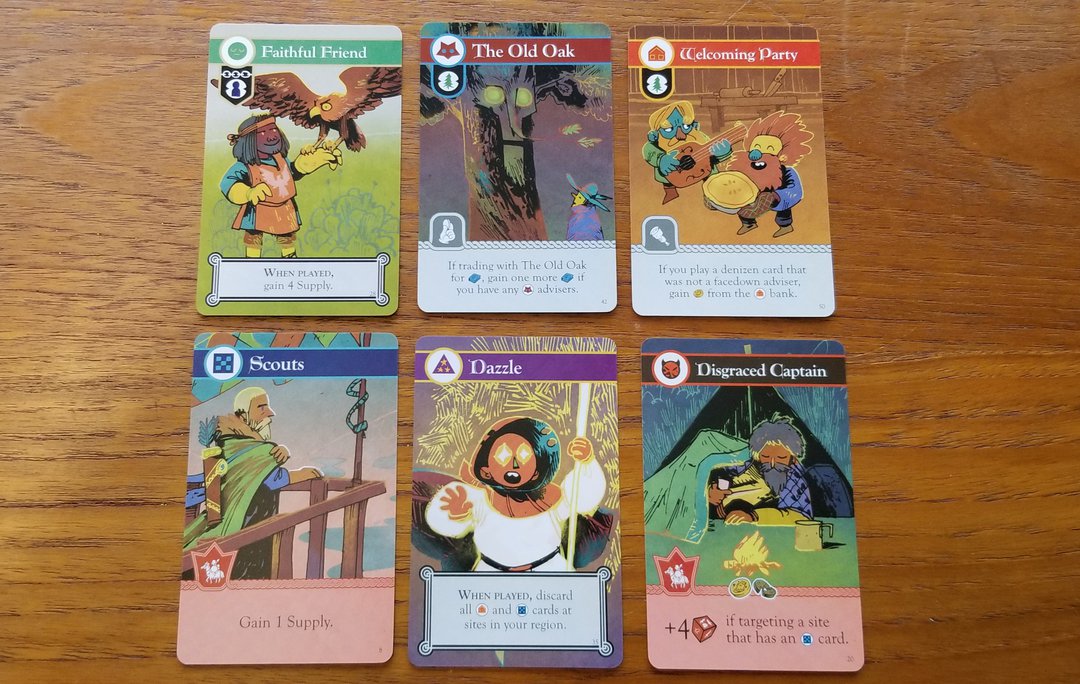
Have a look at just how evocative the cards are!
Ingenious By Design
An oath of Protection is sworn, new military powers agreeing to defend this new kingdom. Yet the wheels of power are turning once again. Those with armies under their command rush out across the land to secure secret relics, consolidating their power bases. No one truly trusts the others. Skirmishes break out, and an impossible defense mounted by a few lone and overwhelmed troops breaks the back of the new Chancellor’s armies. The warlords are quick to snatch up the broken bits of the crumbling, nascent kingdom. A time of great strength and conflict looms as one prominent warlord seizes power.
Talking about Oath’s storytelling capacity is just one of several angles we need to cover. Another is that “secret sauce,” the special mechanics that make this game a little different from things you’ve played before. Naturally, there’s no better place to start than with the “map.” I’m using massive air quotes here because Oath doesn’t employ a map in the traditional sense. You won’t find a standard, static land printed in permanent ink here. But I’m getting a little ahead of myself.
Imagine for a moment you’re the game’s designer. You’re facing a problem. You need something like a map for players to drop armies on, points of interest with which to play area control. However, you’d also like to simulate two things with this map: that the effort it takes to move armies from point A to B changes depending on how close to the center of civilization you are, and that if a person who’s not the ruler wins the conflict they change where the new capital is established (and thus change the relative costs to moving things around). You can see how using a static map would be a problem. Oath’s board solves this by delineating three areas, from nearest to furthest: Cradle, Provinces, and Hinterlands. The costs to move between these zones are marked right on the board for reference. Within each of these areas on the board, oversized cards are used to mark points of interest, and these are the locations that are fought over. Depending on who wins, the locations on the board are shifted into the Cradle, denoting not only the new seat of power but then how far the other, preserved locations are in relation to it. It’s a genius move that perfectly lets your hidden city in the mountains become the new holy city of your empire, while locations that fall into obscurity are shuffled back into the deck to be rediscovered at a later time.
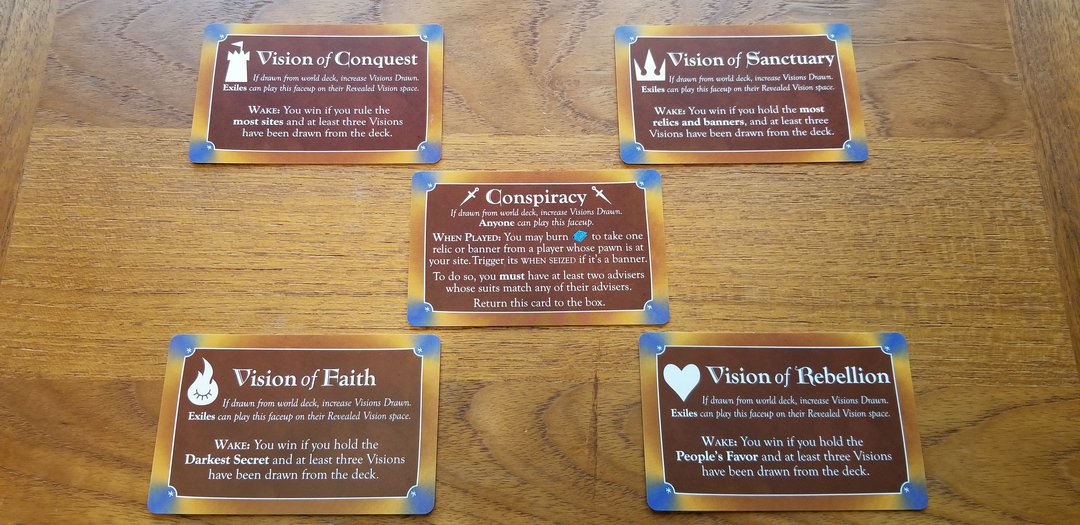
The oath is just one victory condition! Exiles can also win through vision cards. Unlike the Root dominance cards, these appear in wins more like 50% of the time.
Another mechanic I can’t quite get enough of is how the campaign system works. That is, when you want to use your little meeple armies to bash your friends and take their lunch money. Most wargames see you fighting single battles across multiple turns, slowly spreading your color pieces across the board. In Oath you’re certainly welcome to try the slow and steady approach, but you can also set your sights so much higher. You can declare, with some restrictions, vast swaths of territory in a single campaign action. Heck, with a little setup you could point at every single location controlled by a foe, and all their precious relics, and say “I want all of it.” Yes, in one single, sweeping campaign. Of course, the more you target, the harder the rolls become. Get too greedy and you’re just setting yourself up for failure; in a nice twist, though, if you only just miss your goal you can sacrifice your own armies to make up the difference and boost you into success. Whether a pyrrhic victory is worth it to you is a whole other consideration.
It’s been said that they who dare, win. Oath certainly lets you be as daring as your courage can muster. How do you go about getting what you want? That’s the question this game is constantly asking you. Maybe you do it through superior force. Maybe you seek allies. Maybe you draw lots of cards and play key advisors, taking precious battle tactics into your playbook that allow your smaller force to defeat much larger but less well-trained foes. Maybe you use terrain to your advantage. Maybe you combine several of these things. Maybe you’re starting to understand just how clever this game lets you feel, playing politics or military might in any combination to your liking. Or maybe forcing you into a partnership of convenience if resources aren’t quite what you wish they were.
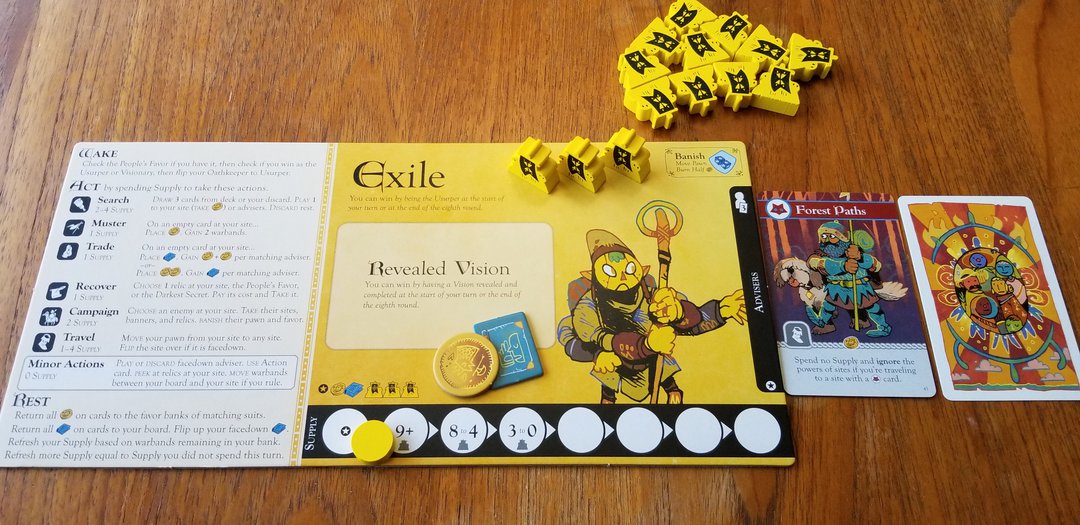
A sample player board. Clean and easy to read, complete with a reference for setup and the actions you can take on your turn.
There are a few other noteworthy systems that flow back and forth as you play and I don’t have the space to talk about them all nearly as much as I’d like, so I’ll give one last shout out. This time it’s to the favor system (one of the game’s currencies). If you install cards of a particular faction into the various locations on the board, you take favor from their associated reserve. When you spend it on cards to activate various actions and powers, it returns to the reserve that matches that card’s suit. Favor on your player board is currency and power to spend accomplishing your goals. Favor in the reserves is power yet to be claimed, the effort a denizen faction can supply to you, but it has limits. What’s the big deal, you say? If a player is entrenched on certain locations, with certain card suits, taking the majority of their favor from only one or two factions’ reserves, another player can drain those reserves to cut the legs out from under someone’s economy. The perfect prelude to an assault. If through cunning or simple miscalculation a citizen stands to usurp the crown from the chancellor, that chancellor can pay favor to “buy out” the citizen and return them to their exile status. If they can afford it. If not, they might see their crown snatched out from their very court! Favor is such a streamlined way to represent economy and the flow of money and power, and I’m in love with it!
Don’t worry if it breaks your head a little the first time you find yourself trying to math out paying favor intentionally to keep your own economic engine looping. Or maybe you try siphoning one opponent’s income source just to be able to afford giving another the boot from your court. Plays like that are hard to plan, but hobbling two opponents with one deft, economic sword swipe feels just that extra bit special when you pull it off, another reminder that this game sometimes lets you feel very clever.
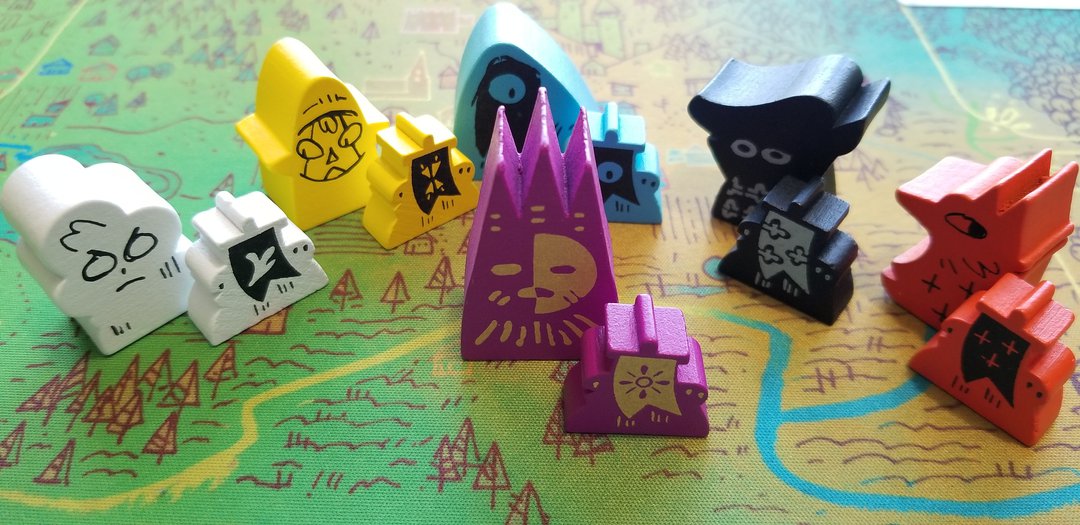
Sometimes when you're the chancellor it can feel like everyone's sizing you up, ready to strike.
The Learning Curve
It has been decreed that only the strongest will inherit the kingdom, and so an age of mighty warlords falls upon the land. The followers of the once Chancellor want their throne back, and they march forward with resolve to meet the ruler’s armies. Elsewhere other leaders install supportive agents among the populace, peacefully playing around the conflict, looking for the right time to strike. At the eleventh hour, revealed devotees of the once-mad king bring forth a long-lost heir, claiming citizenship and nearly reclaiming in one fell swoop everything their ancestors had lost. But the conflict continues, and the ex-chancellor, now a self-styled Bandit King, steals the royal scepter. The very symbol of power in the land now his, he declares himself a loyal citizen. Not even the devotees with their long-lost heir giving claim to the throne are enough to stop him, and the Bandit King claims all the land as his to rule once again.
Up until now, if you haven’t taken a peek at the rules to Oath, I might have you convinced that this game is some ultra-streamlined, easy-to-learn, breezy wargame, and my gosh I’m so so sorry if I’m leaving you with that impression. Oath isn’t exactly the heaviest game I’ve seen, and it does play rather smoothly once you’ve got your head around it, but I need to set the record straight here. This game can be challenging to learn on its first pass, especially if you’re the friend that’s buying the thing and is expected to know it front to back so they can teach friends. I don’t want to scare you, but we need to talk about the heaviness of this game. I’d say it rests somewhere around the medium to medium-heavy end of the spectrum depending on your tolerance for games with more rules. There are some saving graces, though. We’ll get to those in a minute.
One thing that hasn’t changed since my first impressions from PAX Unplugged is the level of difficulty in learning this game as explained to me by the designer himself. I’ll stand by that one. Cole describes this game as, and I’m paraphrasing here, “about as hard to learn as two Root factions.” What this means is that it’s tougher to learn at first but easier to play in the long run. If you’ve never played Root, have a look at my review of that one too; you’ll see that each faction is asymmetrical and requires you to learn new rules for each that you try. However, whereas the barrier to entry in Root is one faction, the curve to mastery includes learning all of them (four by default in the base game, and each expansion adds two more). Oath by comparison flattens out at the “like two Root factions” level. It’s more to learn up front, but once you’re comfortable with the rules, there isn’t much else to know. So know what you’re getting yourself into with this one. It’s a fairly big rules pill to swallow, but if that doesn’t deter you, knowing the bulk of that work is frontloaded could be a plus.
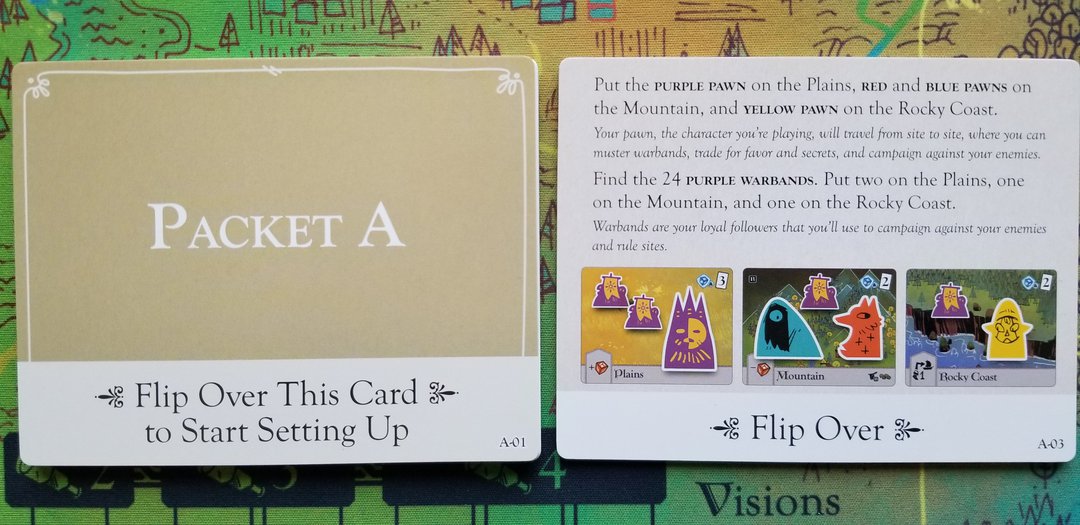
Setup cards provided within the presorted decks of cards help you put everthing together for your first run!
Thankfully, the game is fully prepared to address this concern. It comes with all sorts of helpful rules-related things to get your games going as quickly as possible. There’s a complete and thorough rulebook formatted not unlike that of the aforementioned Root for all your in-depth information needs. You could read this by itself if that’s your style, but there is also a Playbook that explains how to set up a starter game and play through a round of turns; alongside which the game’s cards come preshuffled with setup indicators, allowing you to set up the demo game straight out of the box and learn hands-on. You can then continue playing that game or reset and go again without the guidance. There are some handy player aids to keep around the table, and the rules have a nice “weird things about Oath” section preempting some of the questions that players are likely to have about the more unique aspects of the game. Of note as well, while new cards will constantly trickle into your games, the iconography itself is minimal and easy to understand, so you’ll never find yourself staring at a card, reading it for minutes on end, trying to figure out what it does.
Among difficulties you won’t see in Oath are setup and tear down. The game is thoughtfully designed to be reset for the next chronicle as you pack up the game. Cards are cycled, locations are organized and stacked, and everything is packed away in the box according to a cleanup checklist. The result is that when you open the box for your next game, everything is ready to go within a mere minute or two. Just slap it down on the table, perhaps taking a minute to recap who betrayed who in your last session, and go! A fully functional insert is a very nice thing, but an insert designed to store and roll out your updated Oath game in record speed is a thing of beauty.
I should mention that there’s also a “clockwork prince” included in the game which can stand in for the chancellor or one exile, allowing for solo play or a third player in what would otherwise be a two-player game. I’m always glad to see additions like this in base games, though as with my recommendation regarding Pax Pamir’s second edition, while I won’t discourage you from purchasing if you play all your games solo and are thrilled about this addition, I think you’re missing out if you’re not playing with at least two other humans.
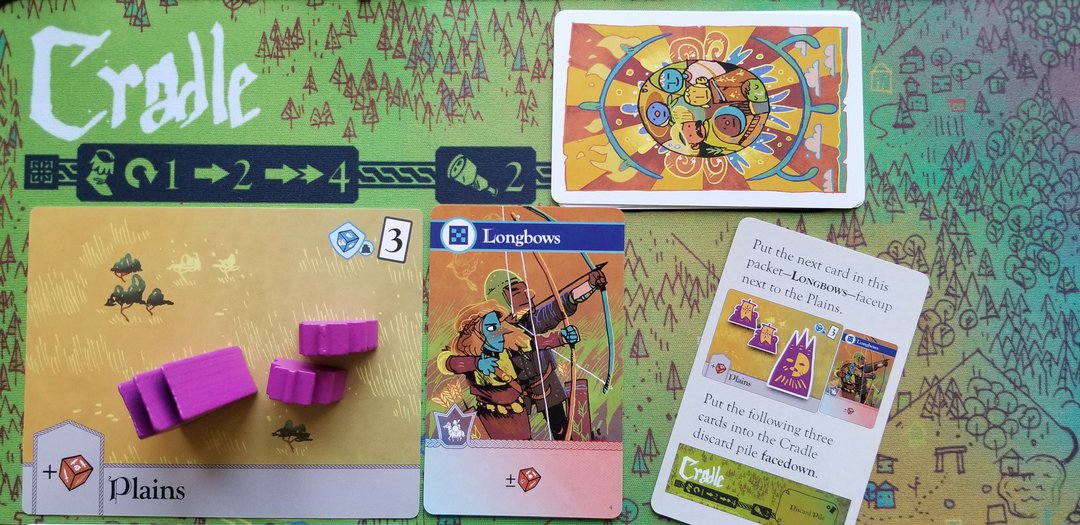
While you can just remove these cards and play a random start for Oath, the setup cards are fantastic at getting everything on the table without having to look at the rulebook ten times.
True Novelty
The table is set. Sides are picked, lines are drawn. All of Oath’s clever systems and all its story waiting to be written lie before you. Is this a conflict you can see playing out on your table? Here are some of my final considerations. I think this game verges on tabletop RPG levels of inter-player gaming consent. There is going to be a lot of table talk, a lot of deals done, and a lot of timely backstabbing. You need to play with a group that’s comfortable with this, moreso even than with the perpetually popular and previously reviewed Root. Remembering that your remnants can continue towards a much deserved revenge plot in your next session definitely helps to lessen the sting of kingmaking, but you’ll still get the most out of Oath when you play it with players that live for the interaction. There are lots of ways to learn the game, as well, but it’s still going to take a few plays before a sense of strategy really starts sinking in. If you can revel in the chaos of picking a few actions, maybe forming an objective you shoot for, and then seeing how things play out, win or lose, Oath offers an experience that likely belongs on your shelves.
Speaking of that strategy, there’s a certain cadence to this game that players will need to come to terms with. The chancellor, as you would expect, starts off in an advanced position but will struggle to hold it as the game draw on. Players will skirmish, draw cards, play those cards into locations or their advisors, and generally try to put themselves into a good position. But the game isn’t over until at least after turn 5 (barring shenanigans involving heavy card drawing and a speedy vision win). This means a couple of things. For one, because you can never be sure what cards will be drawn or played 100% of the time, you can’t form a grand strategy so much as you want to be looking for opportunities to exploit. Secondly, committing too much too early, wiping out your armies or tipping your hand, means you’re not likely to be in a position to seize the win once the end game condition starts rolling. That end game condition too, potentially hinging on a die roll, will upset some players. You might have the perfect plan executed with perfect timing, and the luck just doesn’t swing your way. You have to be ok with this, or with having a contingency. Or with just watching the spectacle of the game and looking forward to the next one.
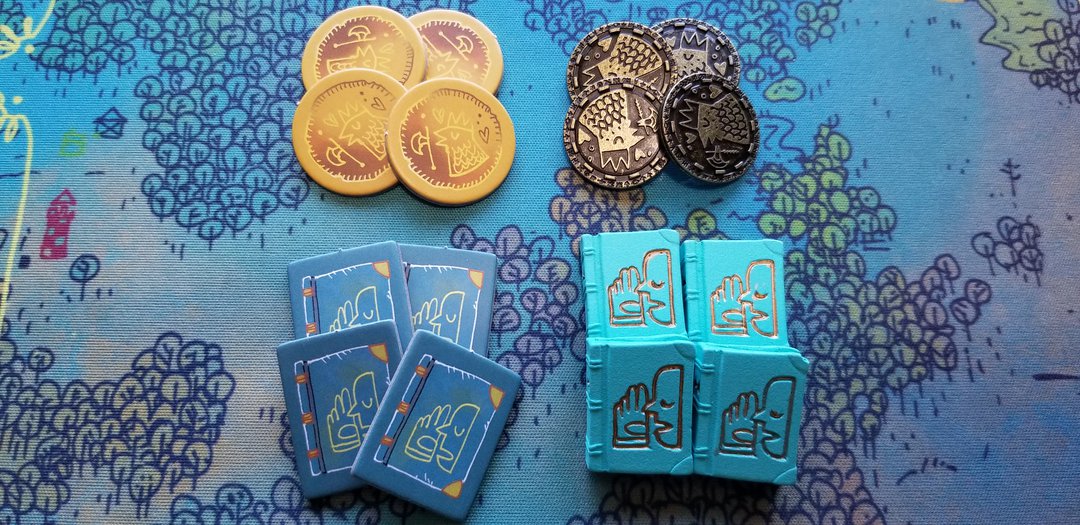
If you like to bling your boardgames, premium pieces are available on the Leder Games webstore. Featured are metal coins and resin secret tokens included in the Kickstarter copy.
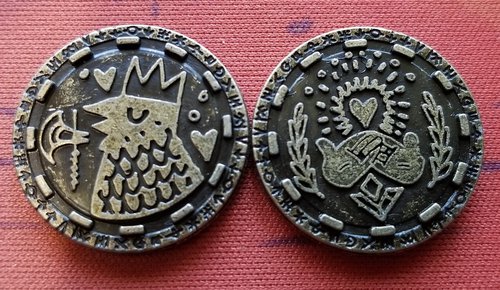
Let me illustrate all this for you with a little story out of one of our games. I was the faction of mad-king devotees, secretly looking to get the throne back that I’d lost generations ago. In my opening hand, I had the choice to take a card called “Long Lost Heir,” giving me the ability to claim citizenship regardless of the chancellor’s powers. It was too interesting to pass up, so I squirreled it away. The game went on. As other players skirmished for small gains, playing to the main oath condition, I silently checked what would be needed to steal a win from within the citizenry. Have the most relics and banners. I started snatching up relics under the guise of powering up for a big fight, waiting for my moment to spring my secret on the unsuspecting chancellor. The turn marker ticked into die roll, game-ending territory. If I waited too long, I might lose my window of opportunity. The chancellor could win by themselves, or they could lose the Oathkeeper token to an exile. I needed their side to be in power when I stole their court from them. I moved, playing my face down advisor card I’d been holding the whole game. Immediately I became a citizen and took the lead for a potential win! I was the last turn before the round’s end. We rolled the die.
I didn’t win. The game continued another round, and another player stole the scepter that would allow them to become a citizen as well, stealing the lead from me and winning the game. I did everything as perfectly as I could have hoped, but due to timing and luck I still lost. And yet I think on it as one of the best games of Oath I’ve played. I had a secret plan that I saw through to perfect execution. I could have won, but that’s not what’s most important to me. The game told a story that I fell in love with. Depending how you see my story should say a lot about your feelings towards this being the right game for you, too.
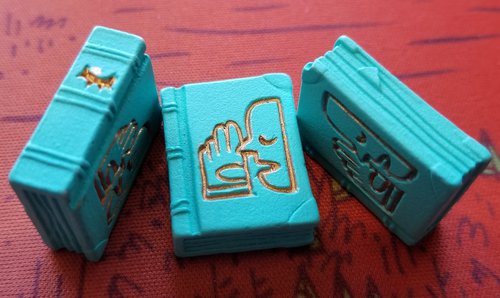
There’s some true novelty in this design. If you’ve read to this point and still aren’t deterred, I strongly recommend picking up a copy. My concerns are minimal at best. They basically boil down to “if you hate interaction, some heavier rules, reactive decision making, and a die roll that ends the game, don’t buy.” On the flip side, if you’ve played any of Cole’s other designs and have been itching for something a little different, a little more narrative in its gameplay, and with more depth that lets you go even deeper down the political rabbit hole, this game is literally perfect for you. I can think of precious few games that allow players to take a blowtorch to the accomplishments of others and still leave everyone grinning, eager for the next game. Maybe even roleplaying their rulers! Oath is one such rarity, and frankly I think it’s a masterpiece. This is a title that will never leave my game library, and I cannot wait to see what new stories I create with my friends.